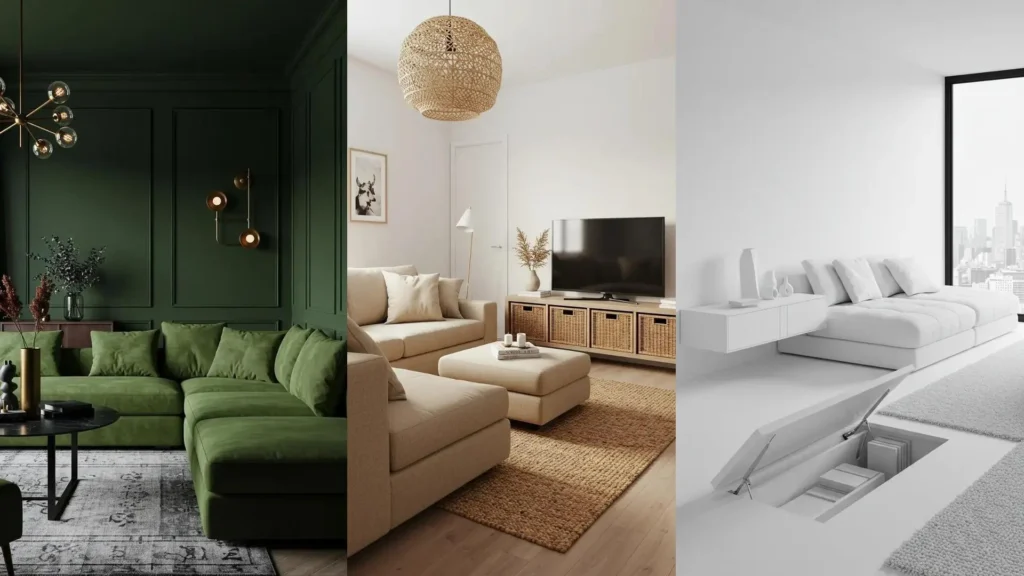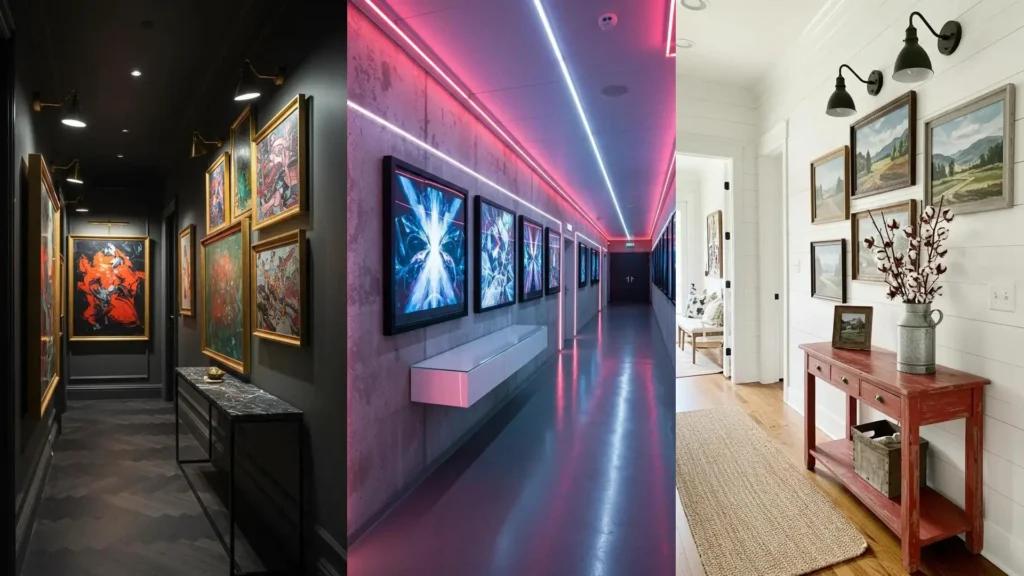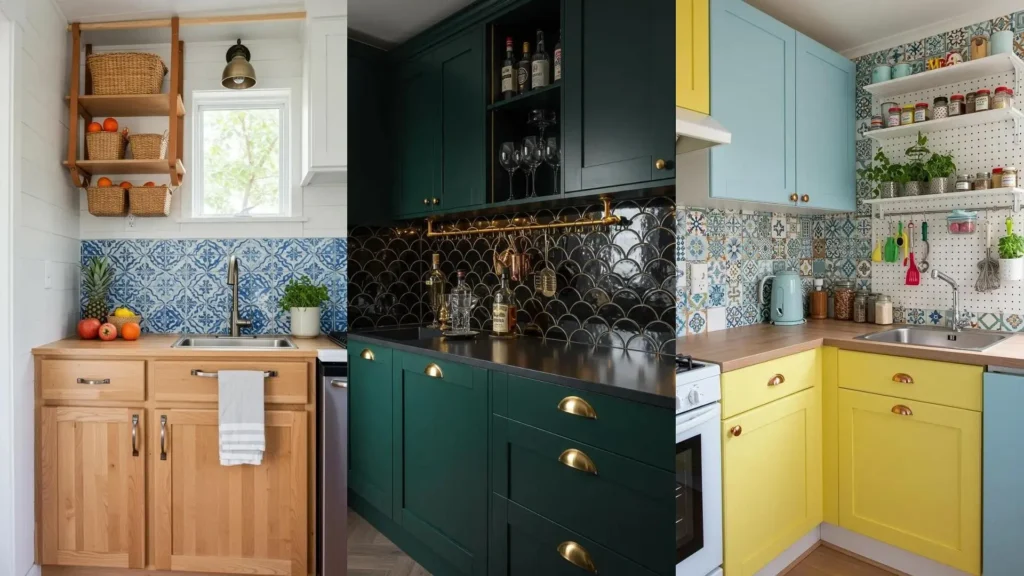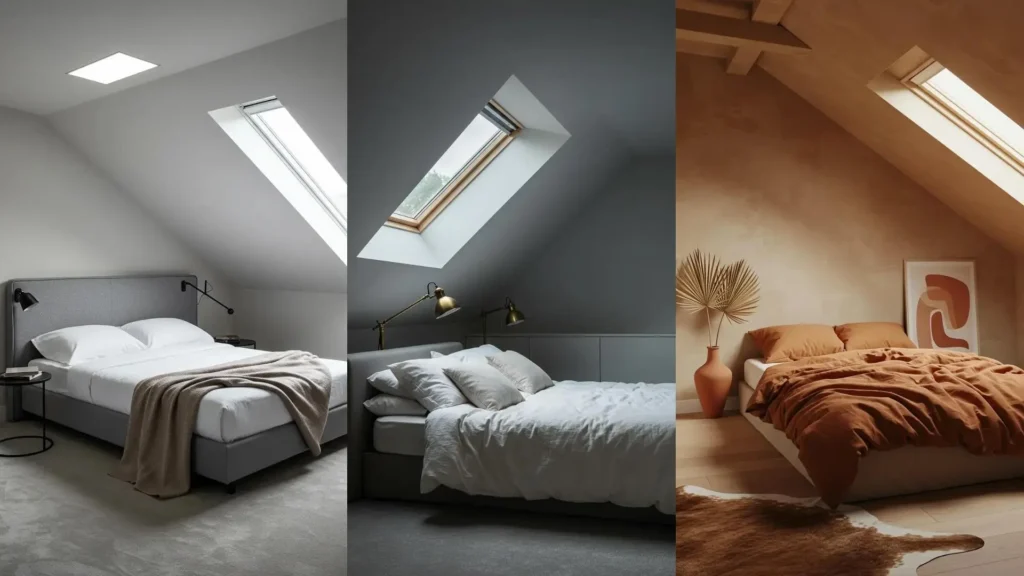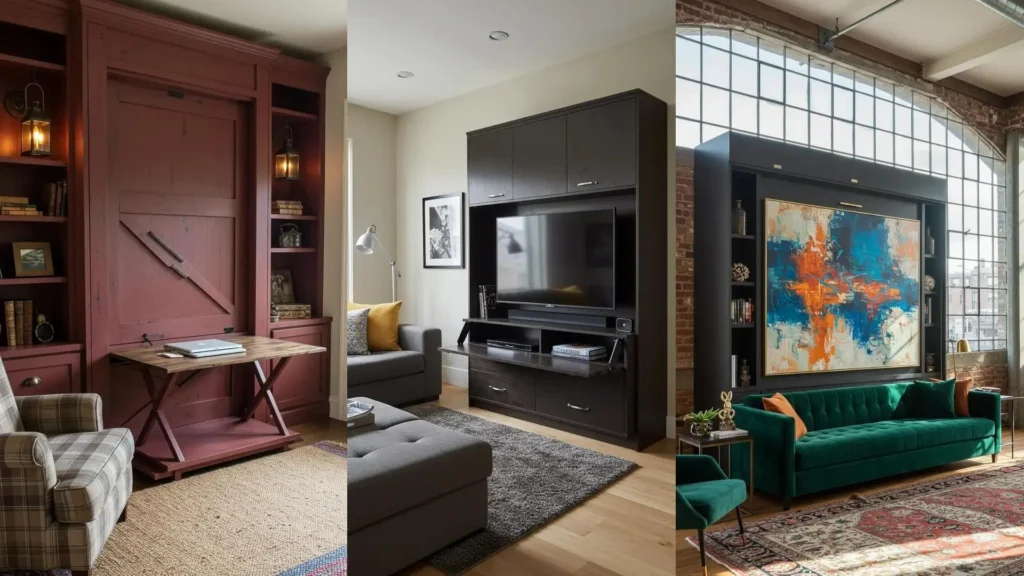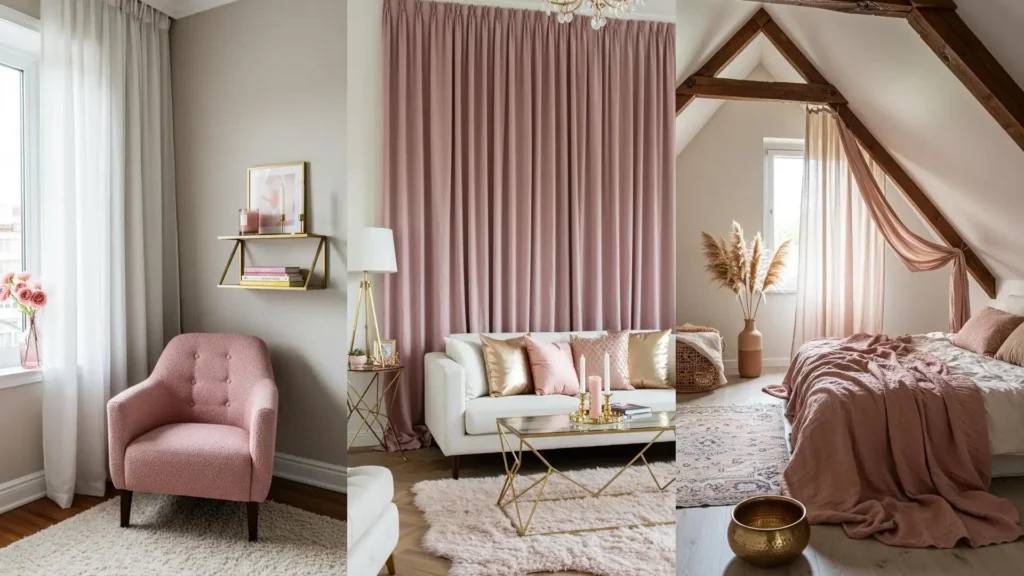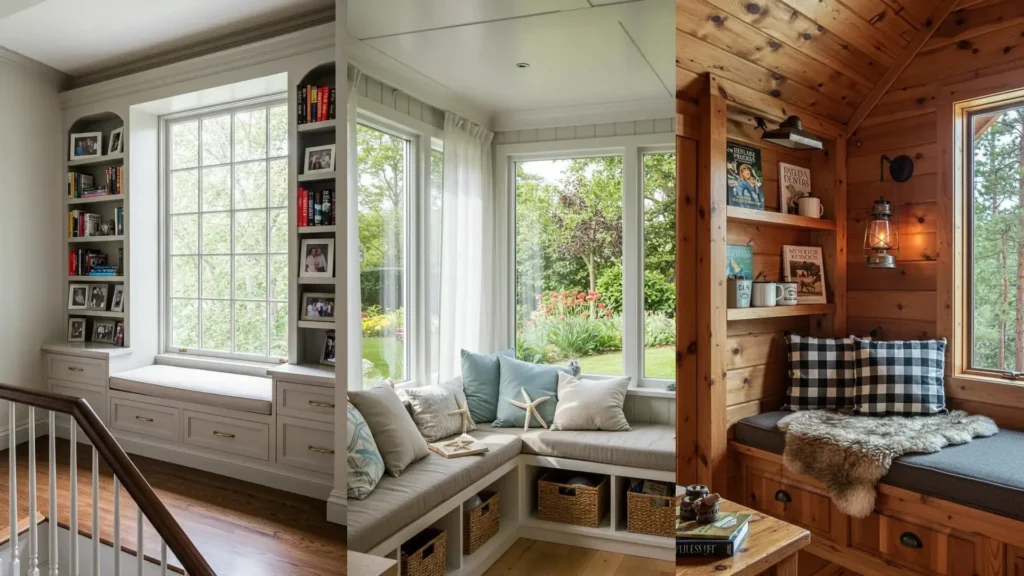A small living room isn’t a limitation; it’s an opportunity for thoughtful, intentional design.
It asks you to be clever, to choose pieces that work harder, and to create a space that feels not just functional, but deeply personal and serene.
Here, we move beyond simply fitting furniture into a room. We explore how modular sofas can adapt to your life, how hidden storage can bring a sense of calm, and how a monochrome palette can create an illusion of boundless space. This is where your small room becomes your sanctuary.
1. The Power of Deep Monochrome
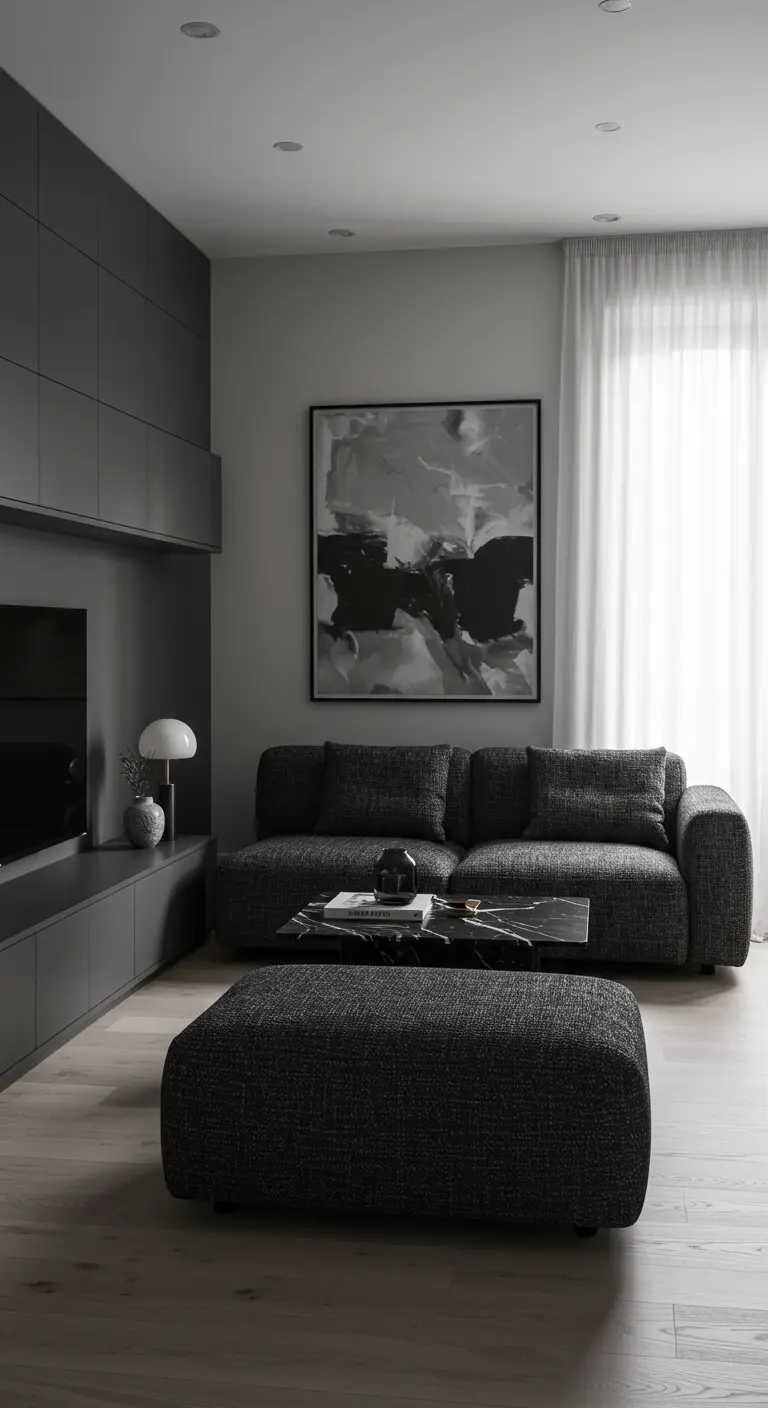
Embrace a dark, unified color palette to create an illusion of depth.
By matching your built-in storage, sofa, and even the wall color, you blur the boundaries of the room, making it feel more expansive and sophisticated.
A single piece of large-scale abstract art prevents the space from feeling flat.
To soften the look, introduce sheer white curtains that diffuse light beautifully.
This approach is a hallmark of elegant monochrome living rooms, where a coffee table in a contrasting material like marble adds interest without breaking the color story.
2. Unify with Warm, Light Tones
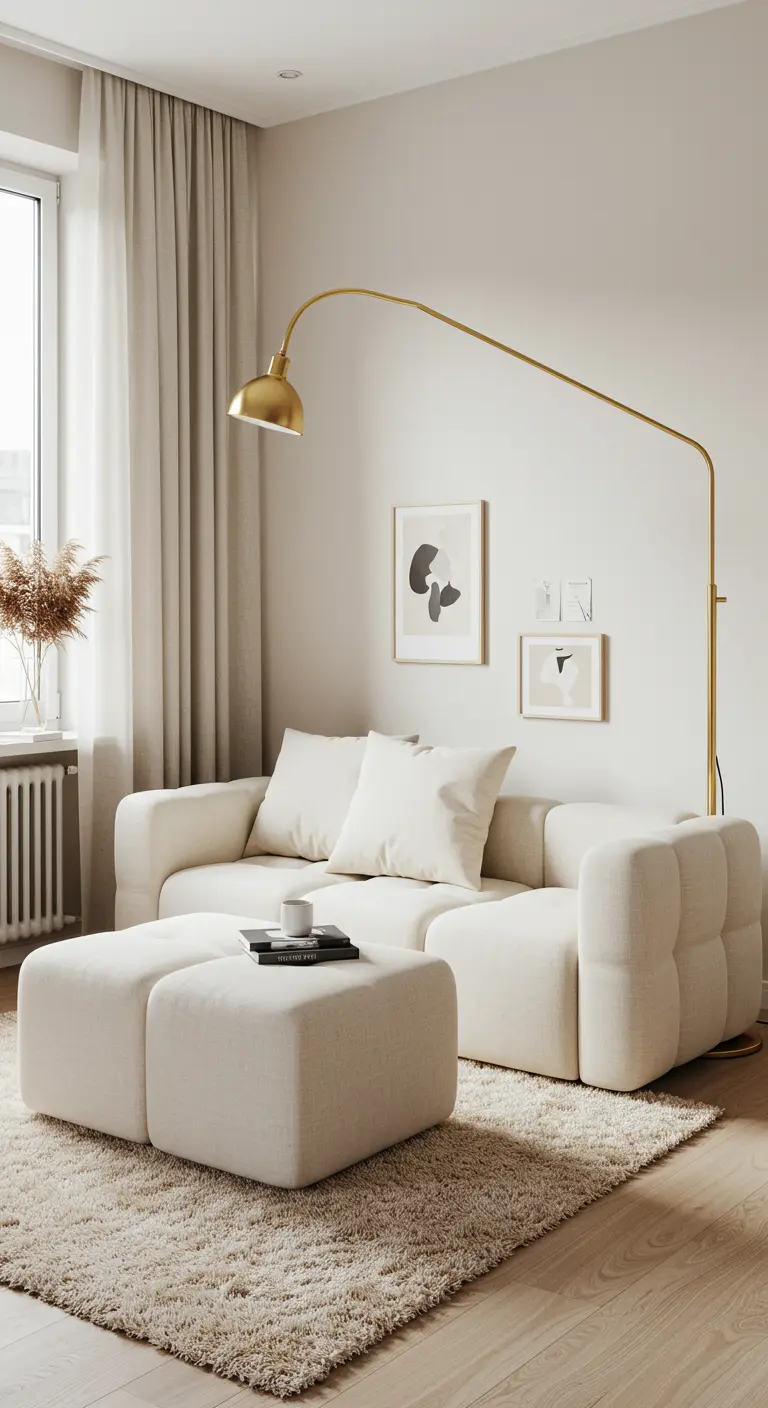
Create a serene and open atmosphere by layering shades of cream, beige, and off-white.
A plush, high-pile rug anchors the space and adds essential texture, preventing the light palette from feeling cold.
Your modular sofa becomes the centerpiece, and using matching ottomans gives you ultimate flexibility—push them together for a daybed feel or separate for guests.
Introduce a single metallic element, like a sculptural brass arc lamp, to add a touch of warmth and glamour.
This approach is central to creating warm, modern interiors with soft, inviting appeal.
3. Integrate a Workspace Seamlessly
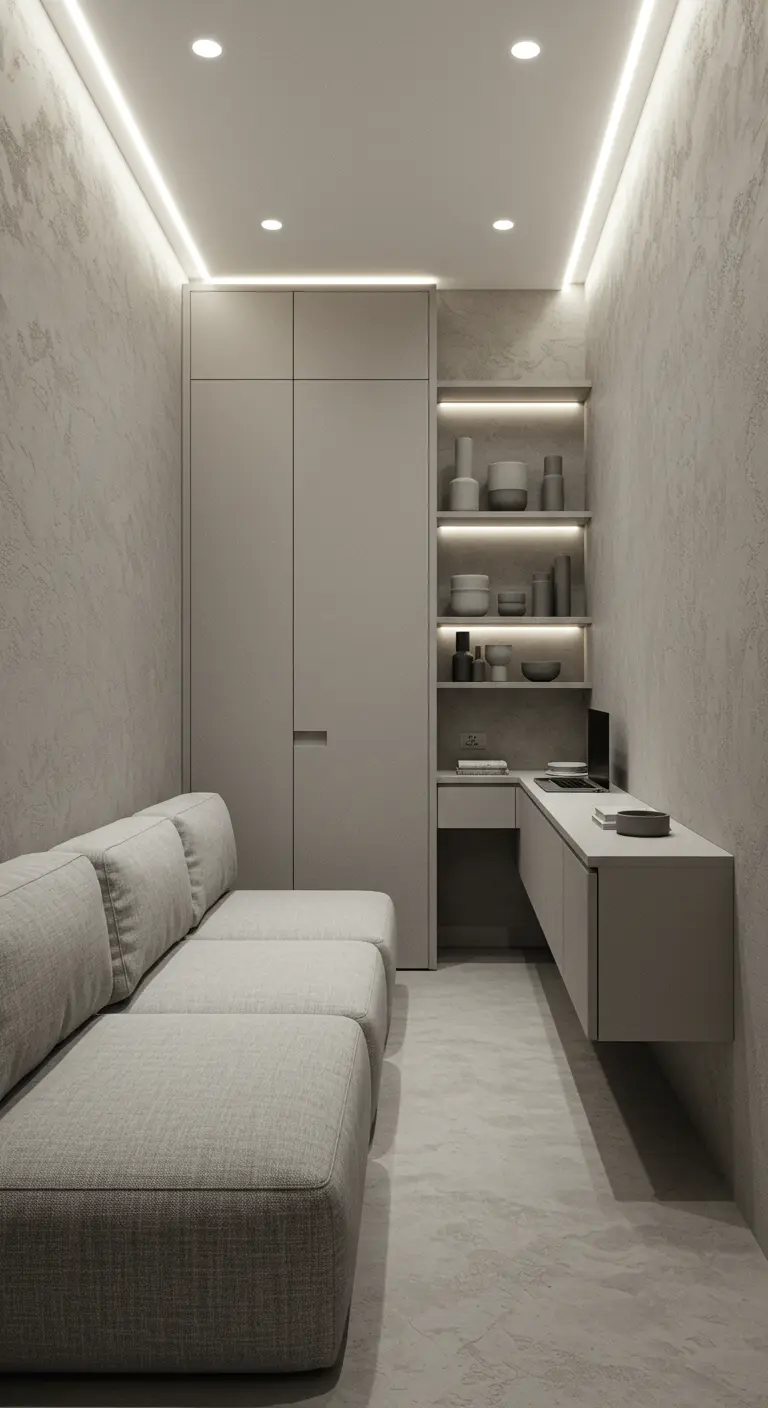
In a truly micro-space, every element must serve a purpose.
Design a single, cohesive unit that combines storage, a workspace, and even display shelving.
By using a consistent color and material for the wardrobe, desk, and shelves, you create a seamless look that feels intentional, not cramped.
Integrated LED lighting under the shelves and along the ceiling perimeter washes the walls with a soft glow, making the narrow room feel wider and more inviting.
This is a masterclass in functional, clean-cut minimalist studios.
4. Embrace the Drama of Darkness
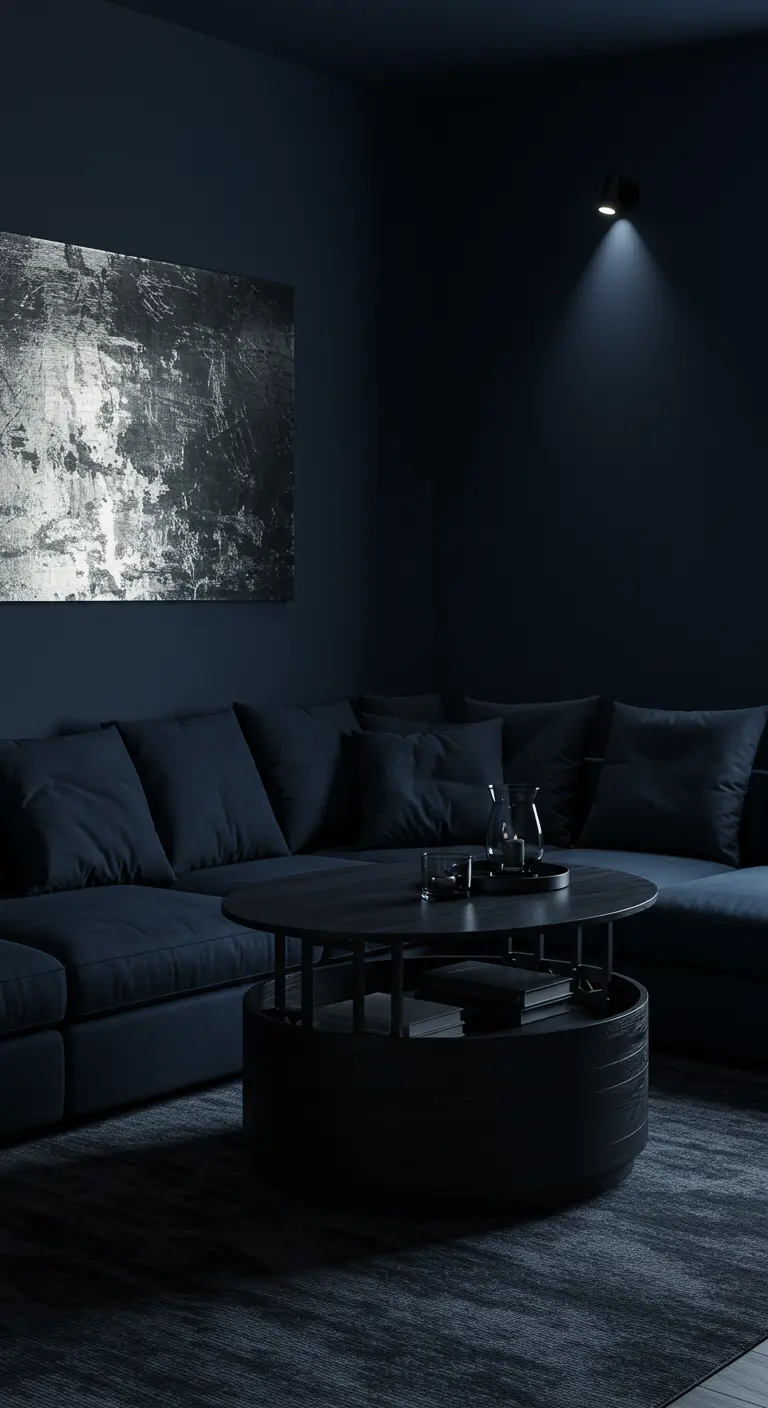
Do not be afraid to paint a small room a deep, moody color like charcoal or midnight blue.
This can create a cozy, enveloping feeling that makes the space feel intimate and luxurious.
Use a single spotlight to highlight a piece of metallic art, creating a dramatic focal point and preventing the room from feeling like a cave.
Choose a coffee table with built-in storage to keep surfaces clear.
This technique is perfect for creating moody small spaces that feel curated and personal.
5. Build In Your Seating for Maximum Storage
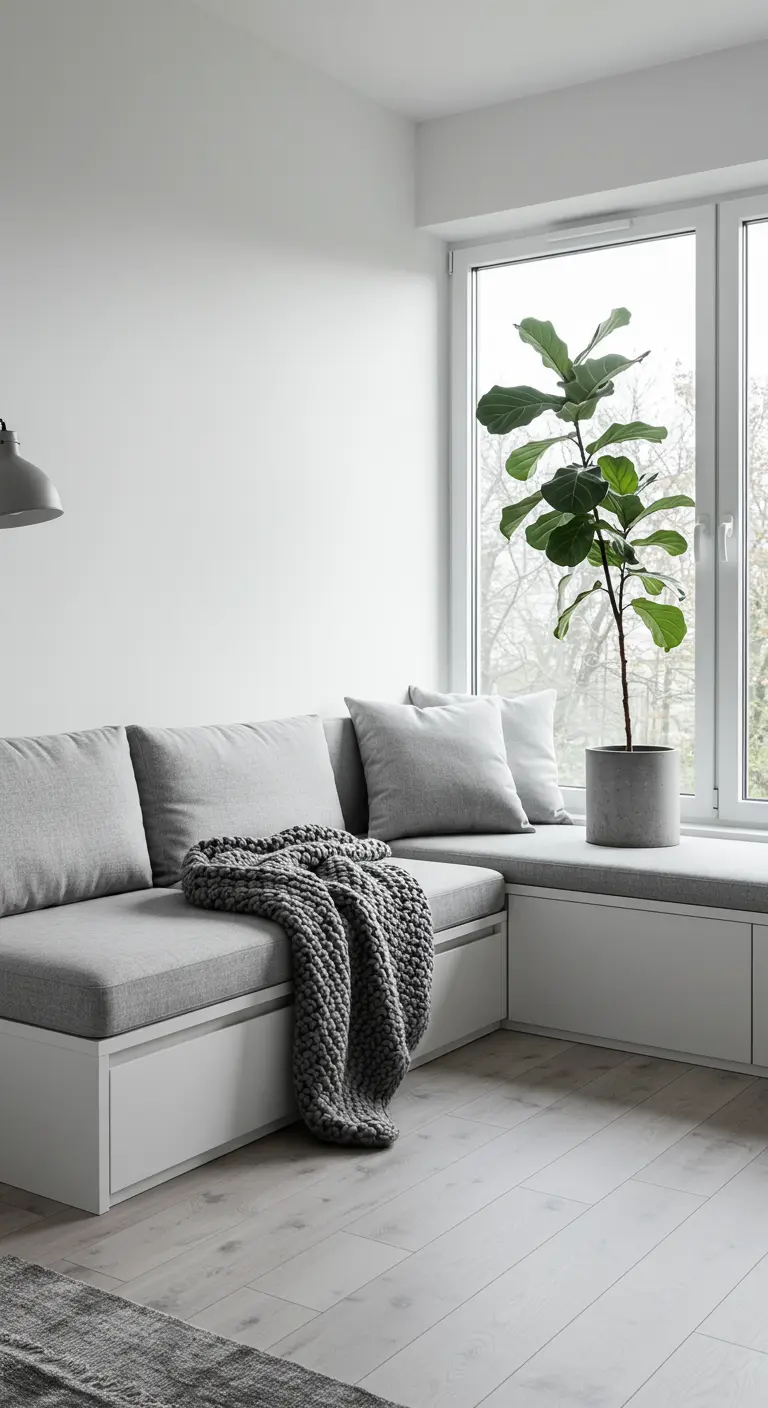
In a small living area, custom built-in seating is one of the most intelligent design moves you can make.
It utilizes every inch of space, especially in awkward corners, and provides an enormous amount of hidden storage underneath.
Here, deep drawers eliminate the need for extra chests or cabinets.
Keep the design simple and the color neutral to maintain a light, airy feel, a simple trick for beautiful nature-inspired small spaces.
A single, tall plant draws the eye upward and connects the room to the view outside.
6. Raw Materials, Refined Function
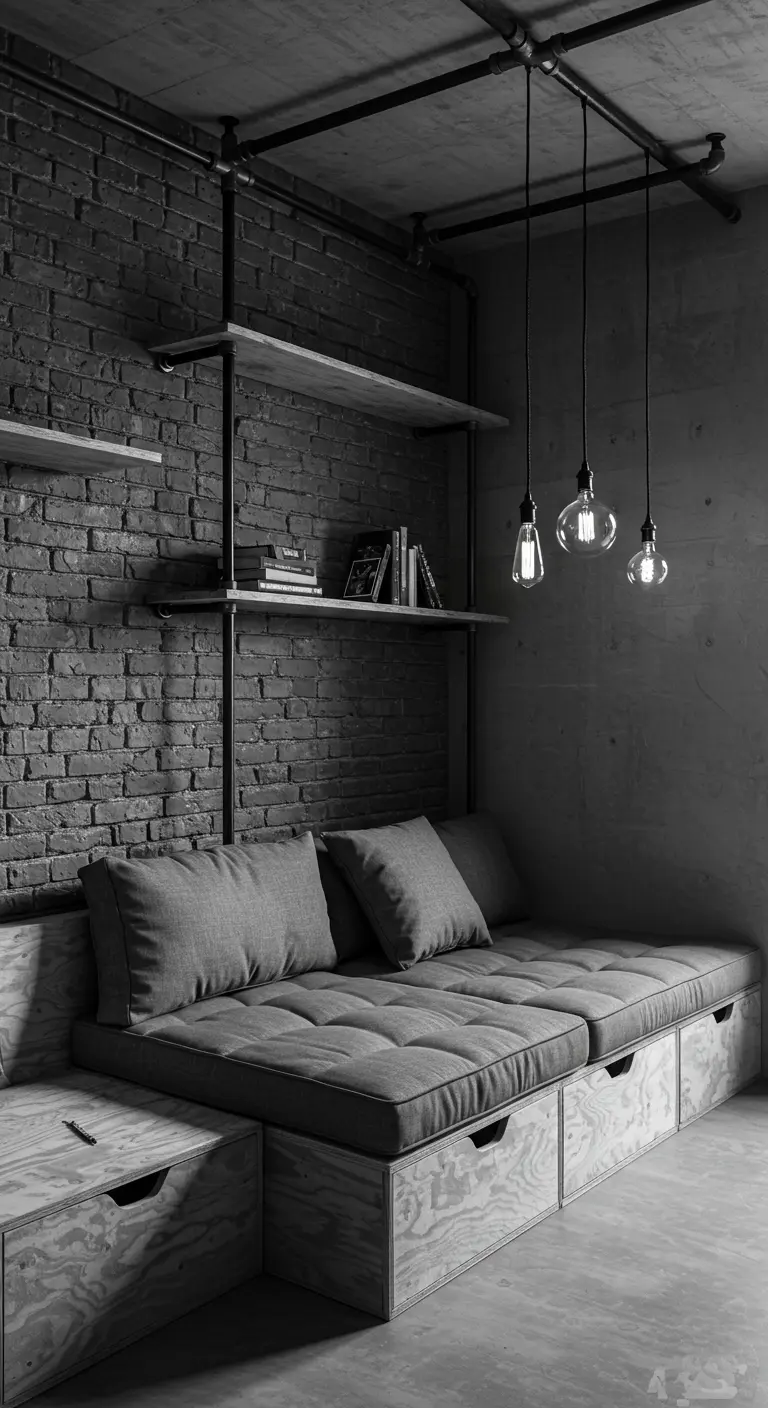
Lean into an industrial aesthetic by combining raw textures with clever, custom furniture.
A sofa built from plywood with integrated storage drawers is both practical and stylistically coherent.
Pair it with exposed brick walls and shelving made from pipes and raw wood.
The key is balance: the texture of the brick is offset by the smooth concrete floor and the simple lines of the furniture.
Pendant lights with Edison bulbs add warmth and character to the utilitarian look.
7. The Sophistication of Tone-on-Tone Texture
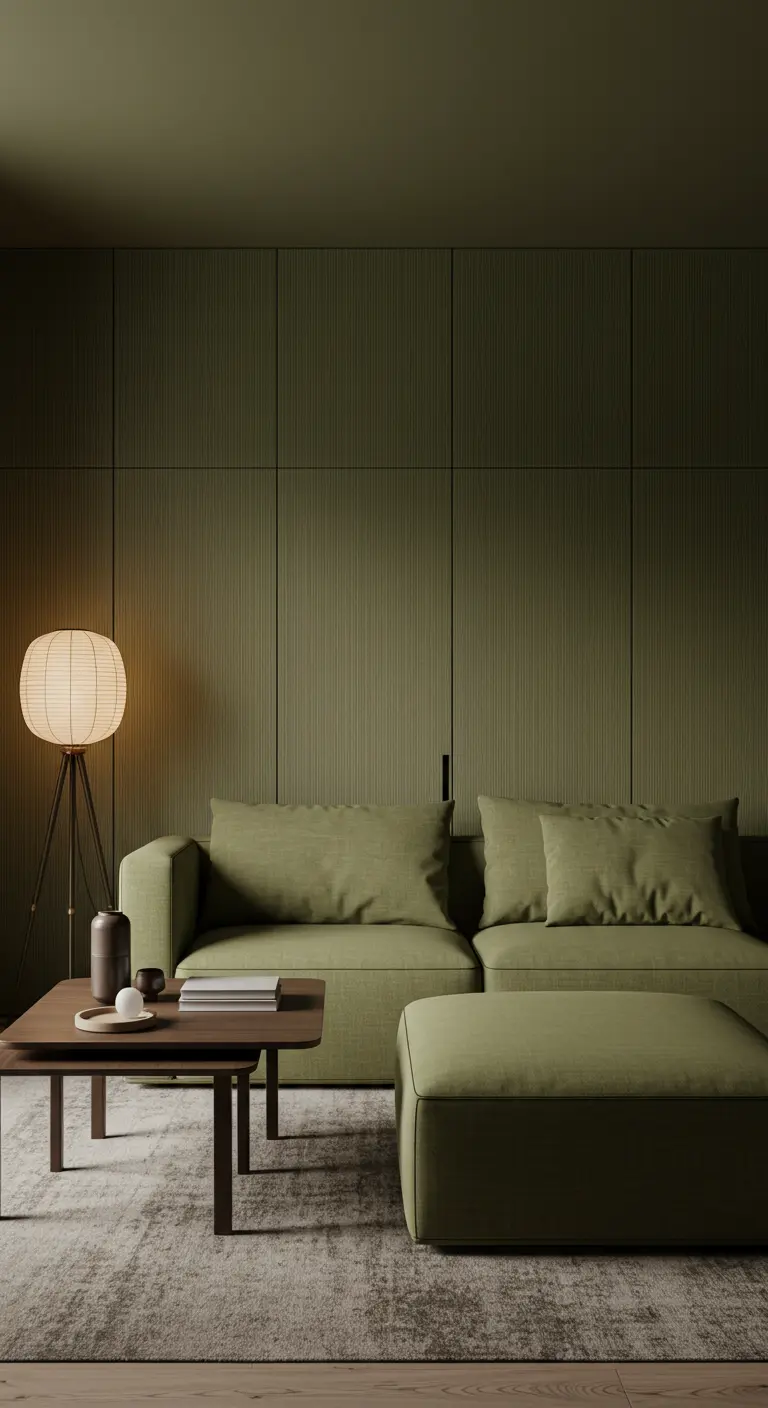
Create a deeply immersive and calming space by committing to a single, sophisticated color.
Here, an earthy green covers the walls, sofa, and ottoman, creating a seamless, cocooning effect.
The secret to making this work is texture: the ribbed wall paneling adds subtle shadow and depth, preventing the monochrome look from feeling one-dimensional.
A paper lantern floor lamp introduces a soft, organic shape and a warm, diffused light.
This is a beautiful way to interpret sage green decor ideas with more depth and personality.
8. Soften Edges with Curtains and Comfort
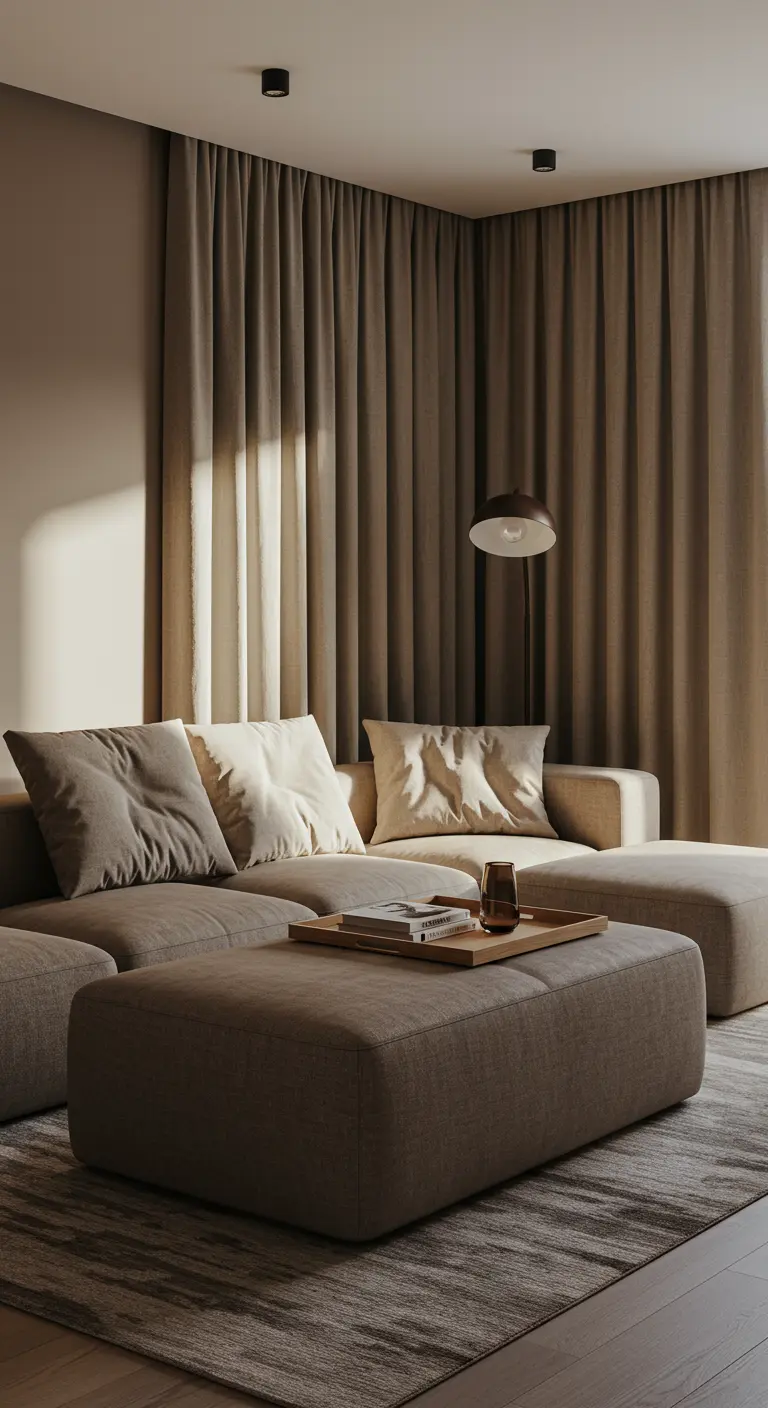
In a corner setting, use floor-to-ceiling curtains to soften the architecture and create a cozy, enclosed feel.
Extending the curtain track beyond the window frame makes the window appear larger and adds a sense of luxury.
A large, low-profile modular sofa with an oversized ottoman invites relaxation and makes the layout feel generous.
Stick to a warm, neutral palette of beiges and taupes to enhance the tranquil mood, a signature of interiors that perfect the greige aesthetic.
9. Uncover Ultimate Hidden Storage
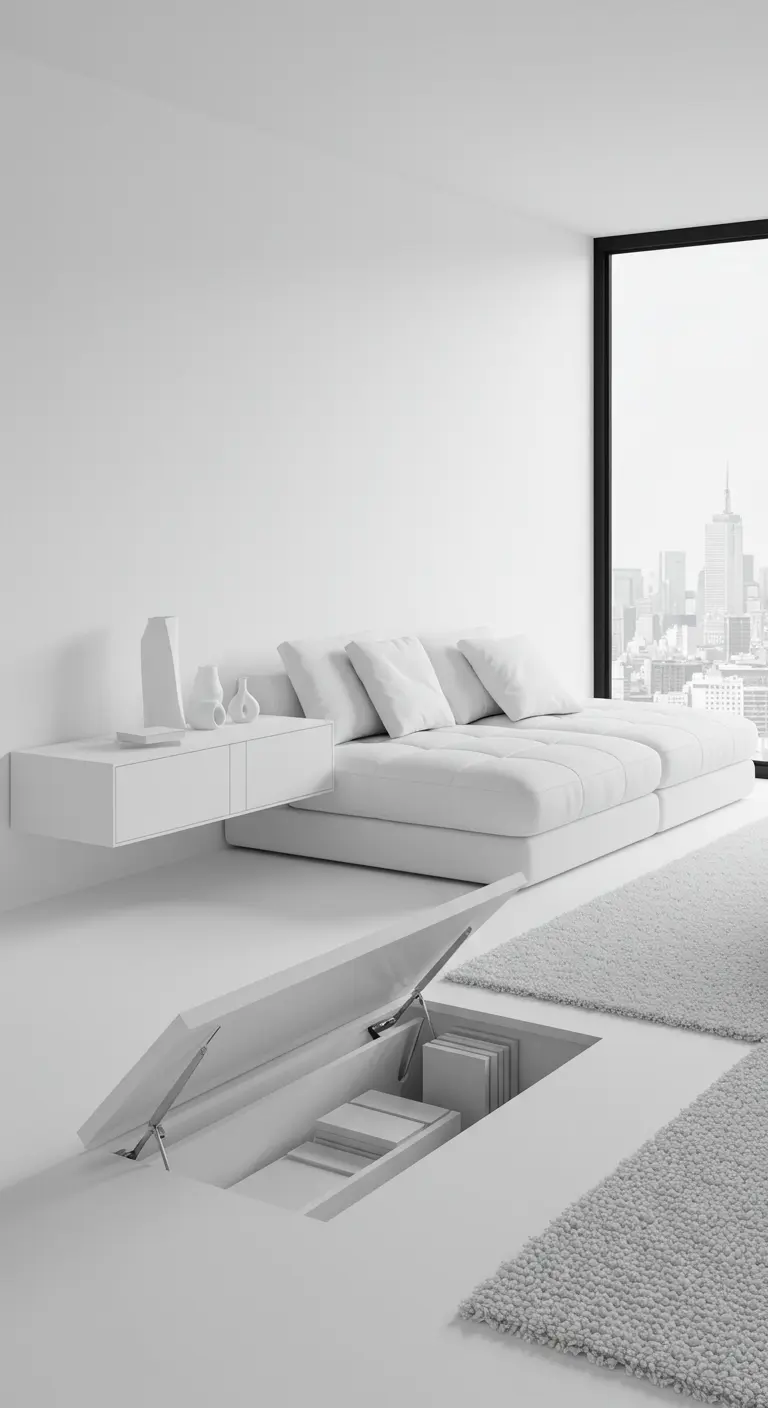
This is the pinnacle of minimalist functionality: storage that is completely invisible.
An in-floor compartment, revealed with hydraulic lifts, provides space for items you don’t need daily, keeping the living area absolutely pristine.
This solution is ideal for lofts or ground-floor spaces where it can be engineered.
To complete the look, opt for floating furniture, like a simple side console, which enhances the sense of weightlessness.
This approach defines minimalist interiors that embrace space and purposeful decor.
10. Go Vertical with Monochrome Shelving
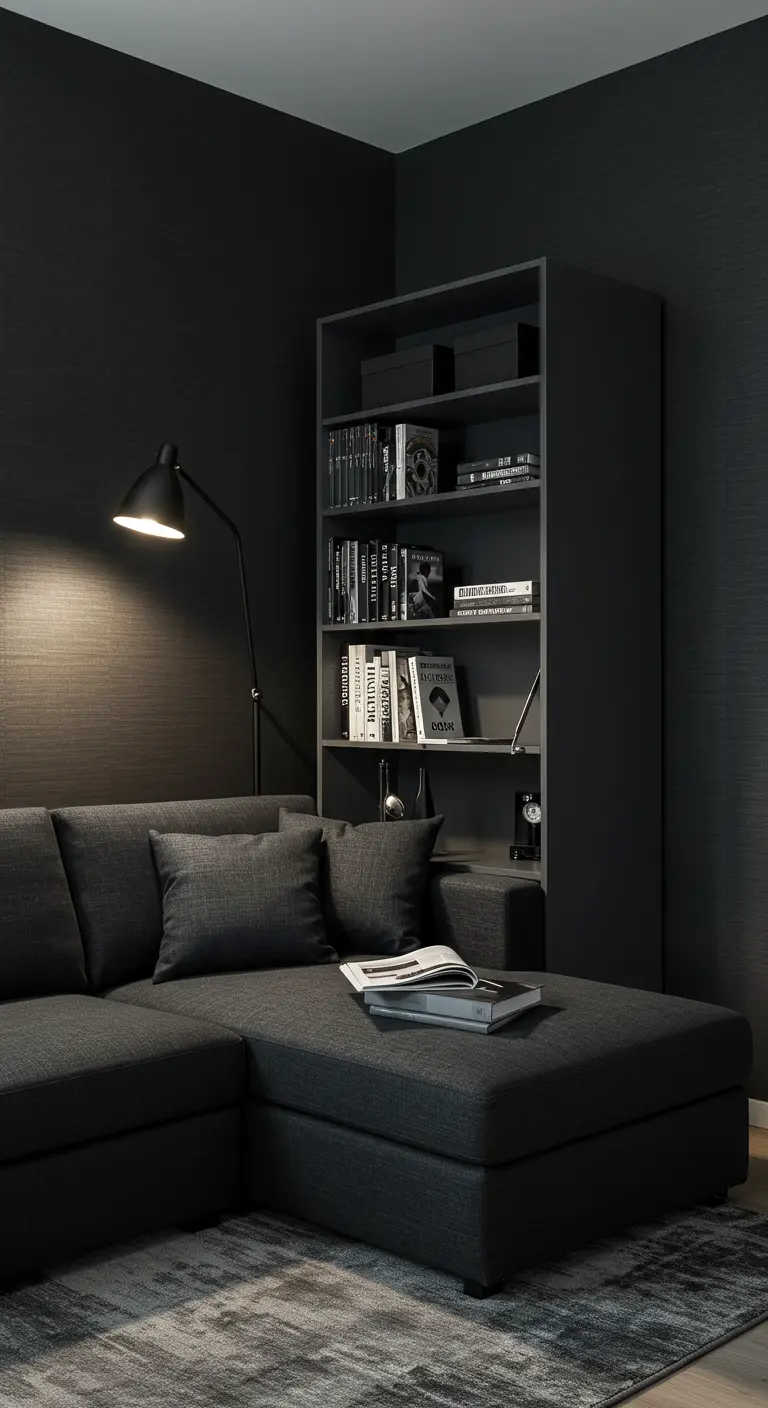
When floor space is limited, think vertically.
A tall, open bookshelf in the same dark color as the walls draws the eye upward and provides ample storage without visually cluttering the room.
The monochrome effect helps the large piece blend in, making it feel like part of the architecture.
A simple, directional task lamp provides focused light for reading and adds a sharp, graphic element to the composition.
This concept works beautifully to create dark, glam spaces that feel cohesive.
11. Maximize Awkward Attic Angles
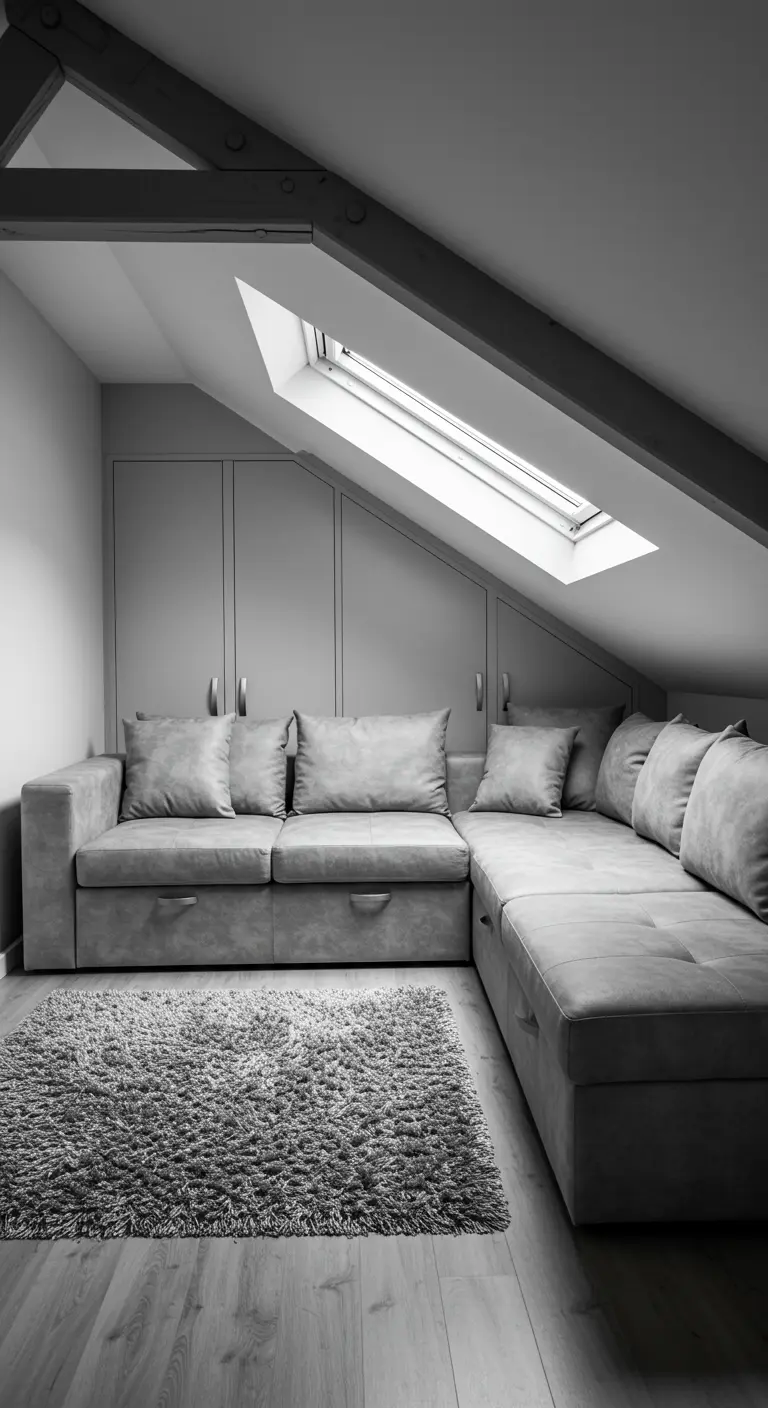
Transform a challenging attic space into a cozy lounge by embracing the unique architecture.
A custom-sized sectional sofa with integrated storage drawers is the perfect solution, fitting snugly under the eaves and using every available inch.
The light from the skylight becomes the room’s main feature, so keep the color palette simple and neutral.
A plush, high-pile rug adds texture and comfort underfoot, making it an ideal retreat.
This clever use of space can turn forgotten corners or even under-the-stairs nooks into your favorite room.
12. Create Warmth with Wood and Integrated Light
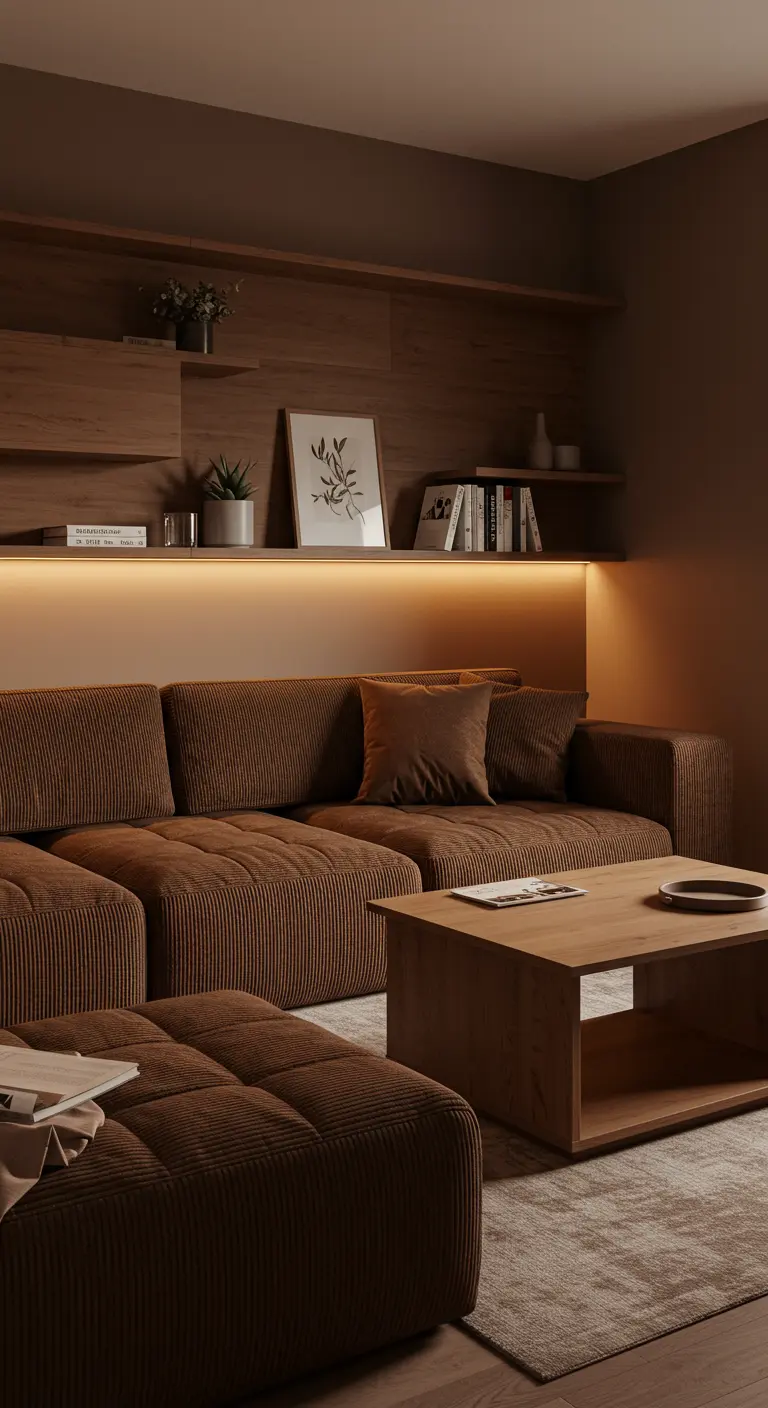
Give your living space an inviting, ambient glow with a recessed wall niche featuring integrated LED lighting.
This not only provides soft, indirect light but also creates a beautiful display shelf for art and books.
Cladding the wall in warm wood panels enhances the cozy, cabin-like feel.
Choose a sofa with a tactile fabric, like this brown corduroy, to add another layer of sensory comfort.
This blend of natural materials and soft light is key to beautiful modern rustic spaces.
13. Soft Curves and Hidden Function
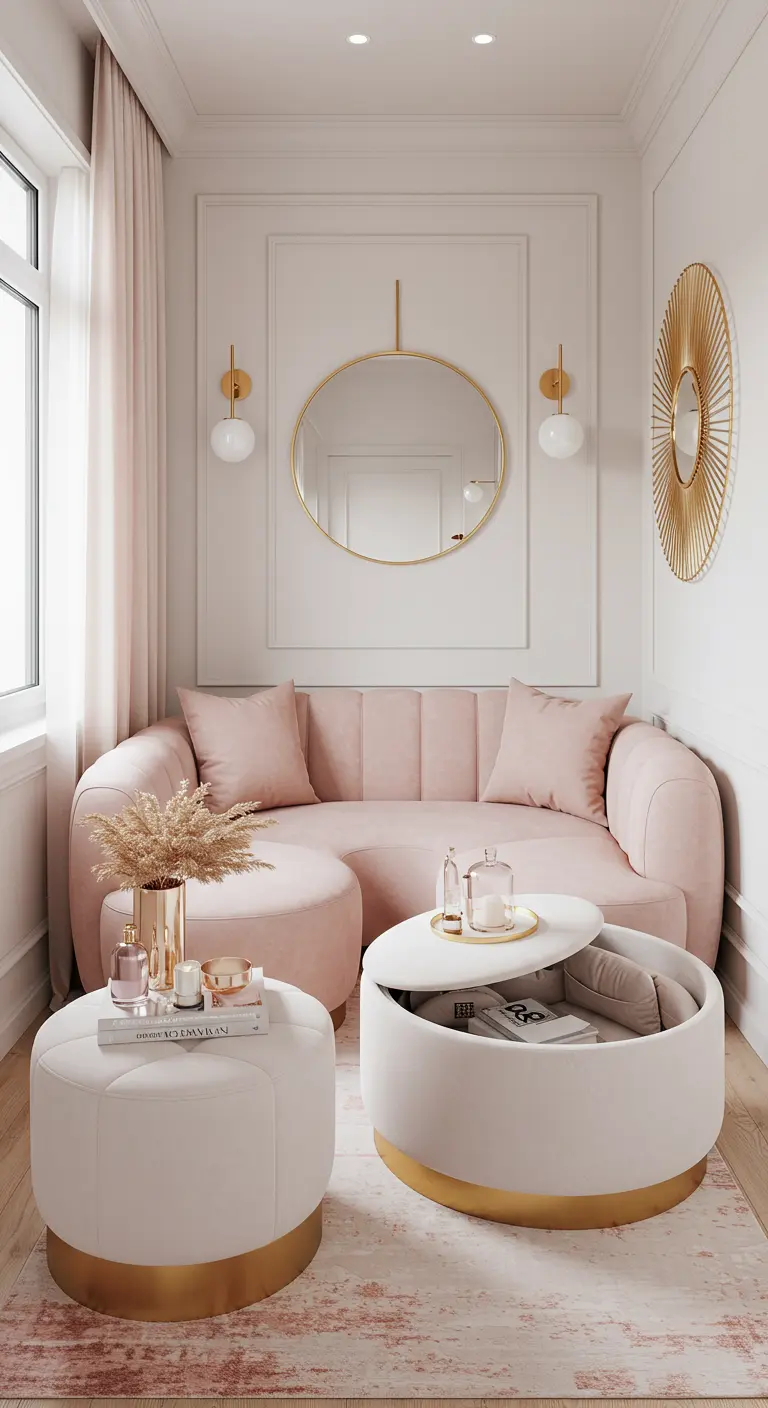
In a narrow room, use furniture with soft, curved lines to improve flow and make the space feel less constricted.
A compact, curved sofa feels chic and inviting, while a clever coffee table offers hidden storage for magazines and remotes.
A light color palette of blush pink and white, accented with touches of gold, creates a glamorous and airy feeling.
This combination of form and function is a hallmark of ultra-feminine, blush pink retreats, applied beautifully to a living area.
14. The Long, Narrow Room, Mastered
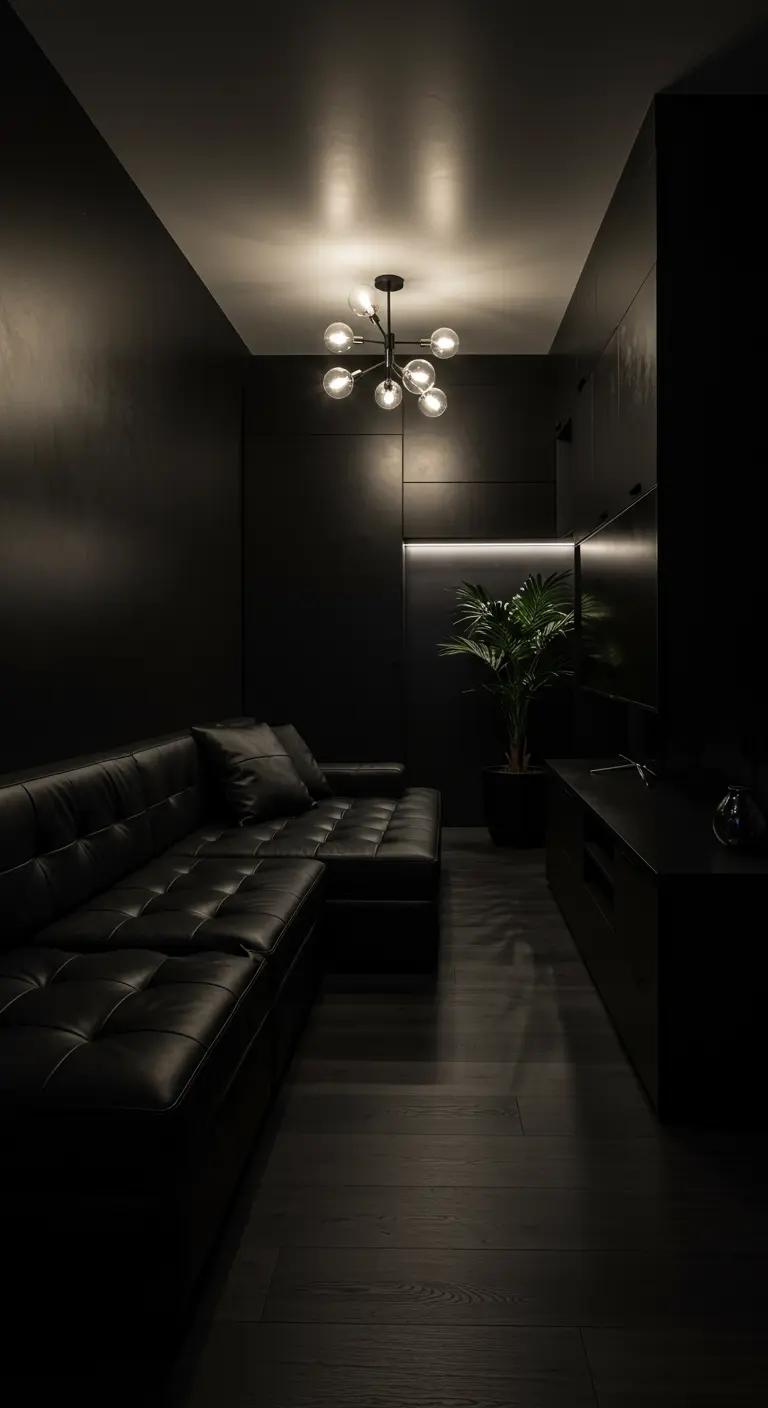
Tame a long, narrow “bowling alley” room by using furniture and lighting to define zones.
A long sectional sofa grounds one end of the space, creating a dedicated lounge area.
In a dark, monochrome palette, the key is to introduce light and texture strategically.
A sputnik-style chandelier adds a sculptural, multi-directional light source that feels expansive.
A single, live plant provides an essential touch of organic life, preventing the bold black and white graphic scheme from feeling too severe.
15. Woven Textures for a Grounded Feel
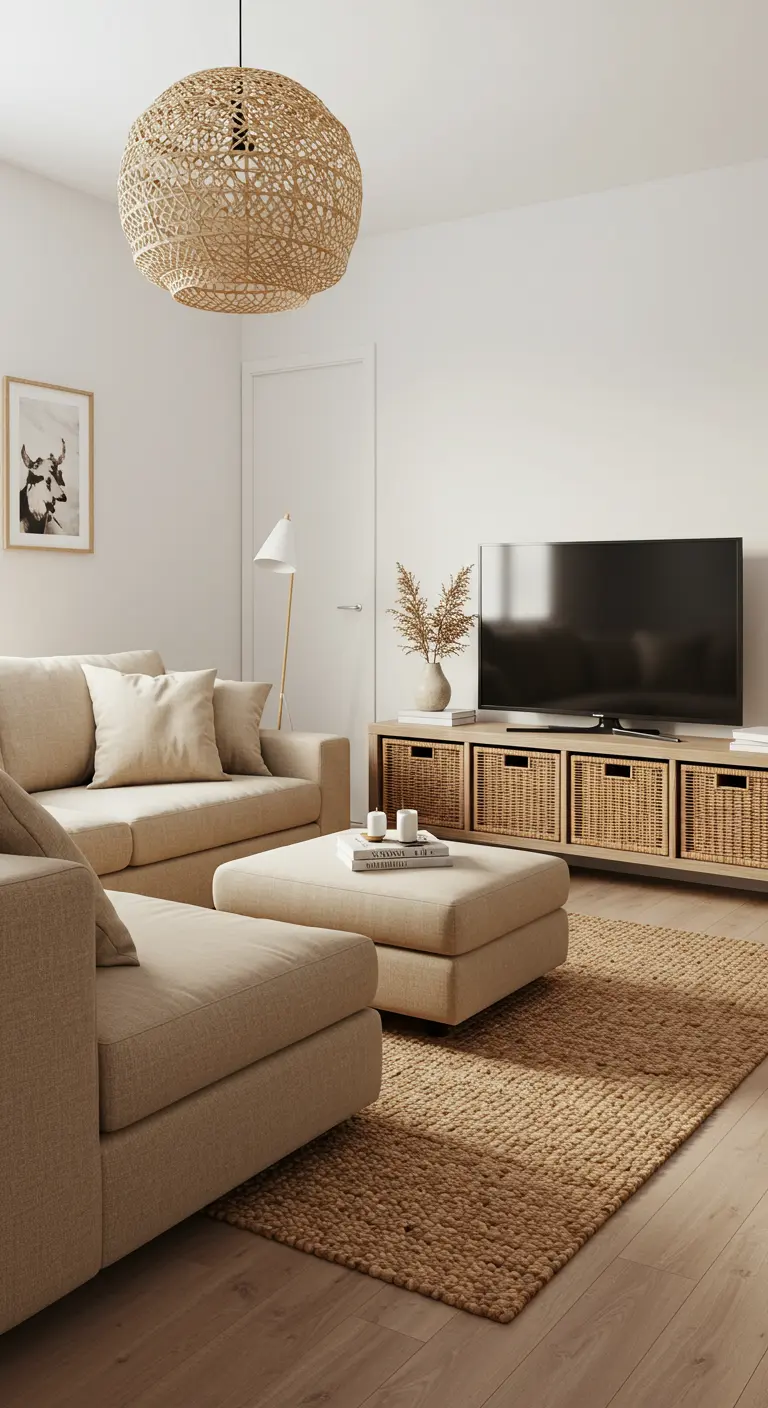
Introduce natural, woven textures to bring warmth and a sense of calm to a modern space.
A large jute or sisal rug defines the seating area and feels great underfoot.
Instead of a solid media console, choose one with open cubbies and use woven baskets for storage—it’s a lighter, more relaxed look.
This approach is fundamental to coastal boho style, proving that natural materials feel at home anywhere.
16. Repurpose with Industrial Character
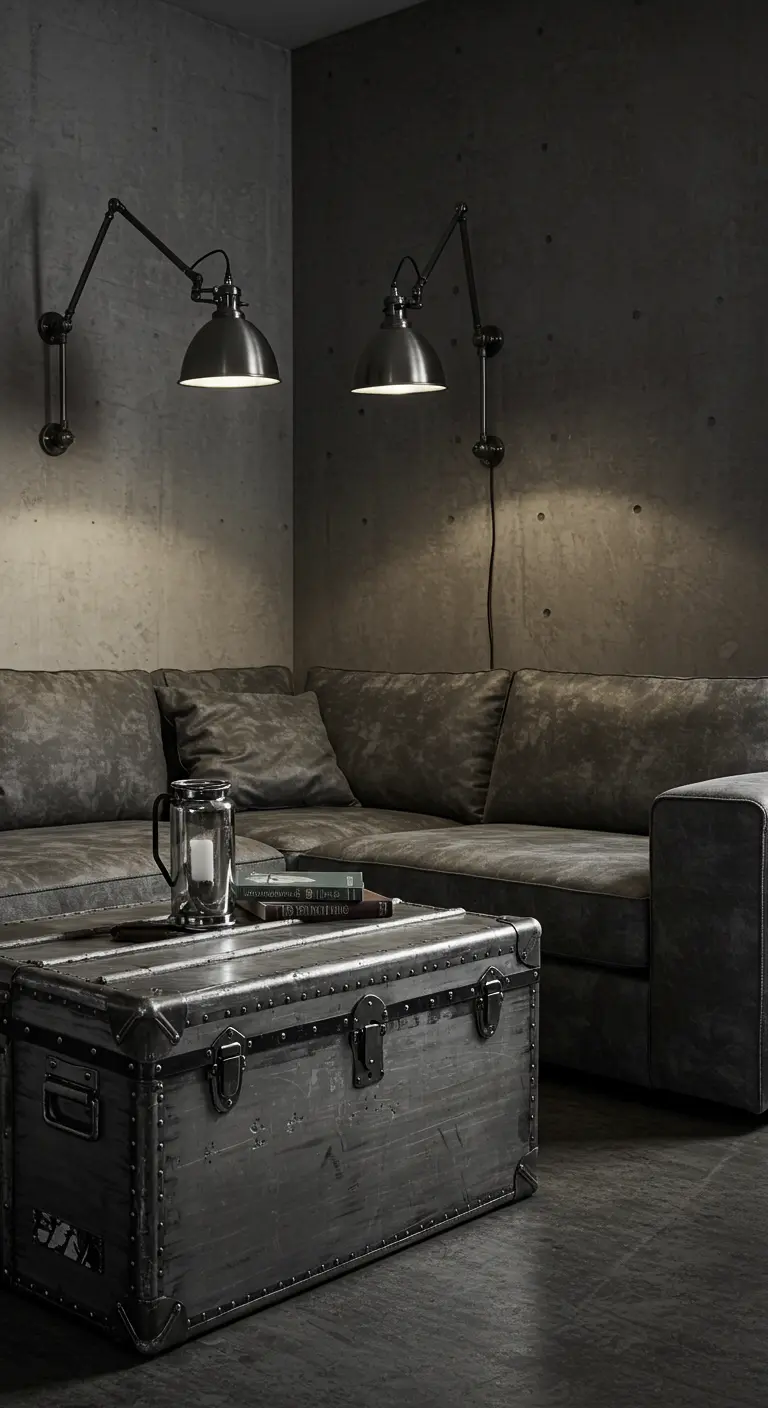
A coffee table can be more than just a surface—it can be the character-defining piece in your room.
A vintage steamer trunk provides massive storage and adds a sense of history to an industrial space.
Its hard-worn texture pairs perfectly with concrete walls and a distressed-fabric or leather sofa.
Complete the look with adjustable, wall-mounted task lamps for a functional, factory-inspired touch.
This is a key element of industrial-chic design.
17. A Wall of Color as Integrated Storage
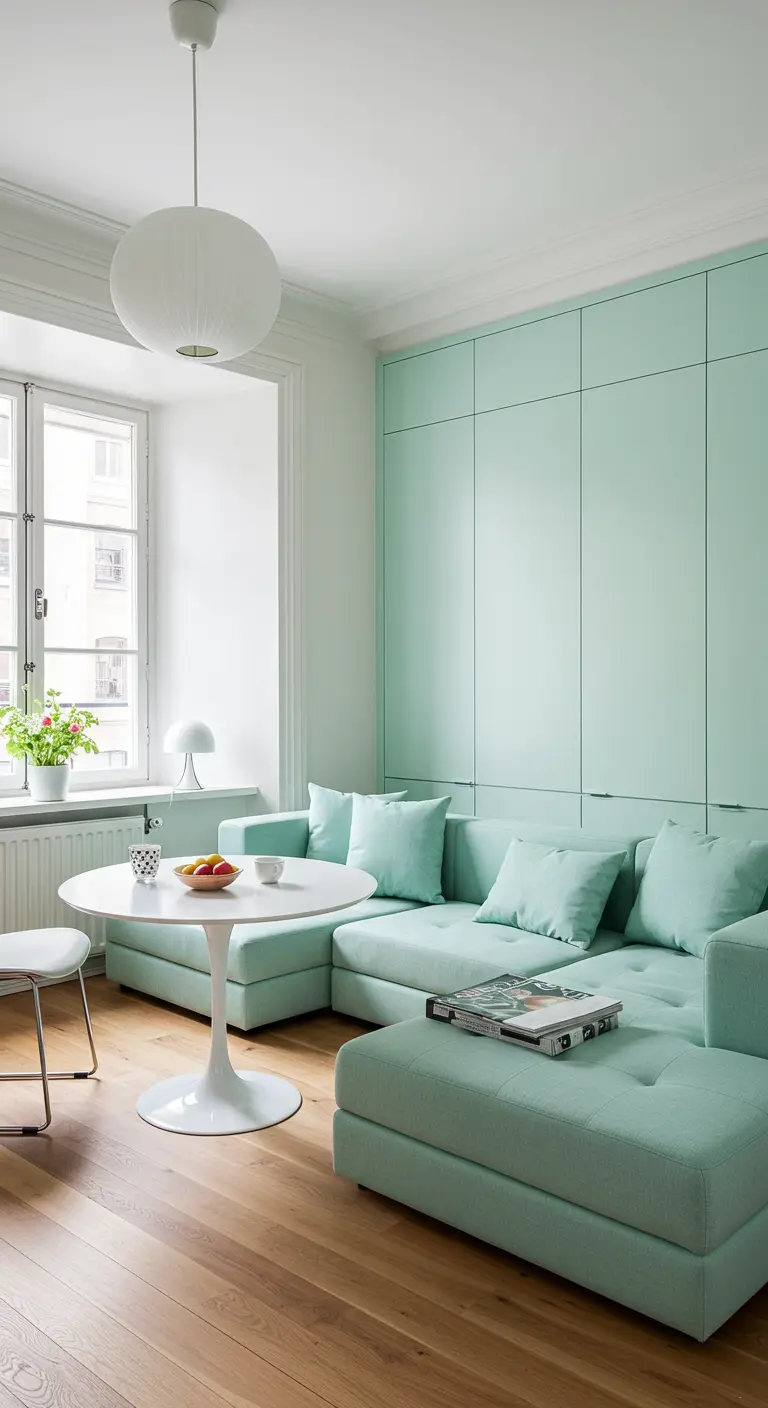
Make a bold and functional statement by designing a floor-to-ceiling storage wall in a single, refreshing color.
Here, seamless, handle-free cabinets in mint green hide clutter and become the room’s main feature wall.
The matching sectional sofa creates a cohesive, immersive color story.
To keep the look modern and light, pair it with iconic white pieces like a tulip-style dining table and a simple globe pendant light.
This is a fresh take on creating playful, color-blocked rooms.
18. Deep Color and Subtle Architecture
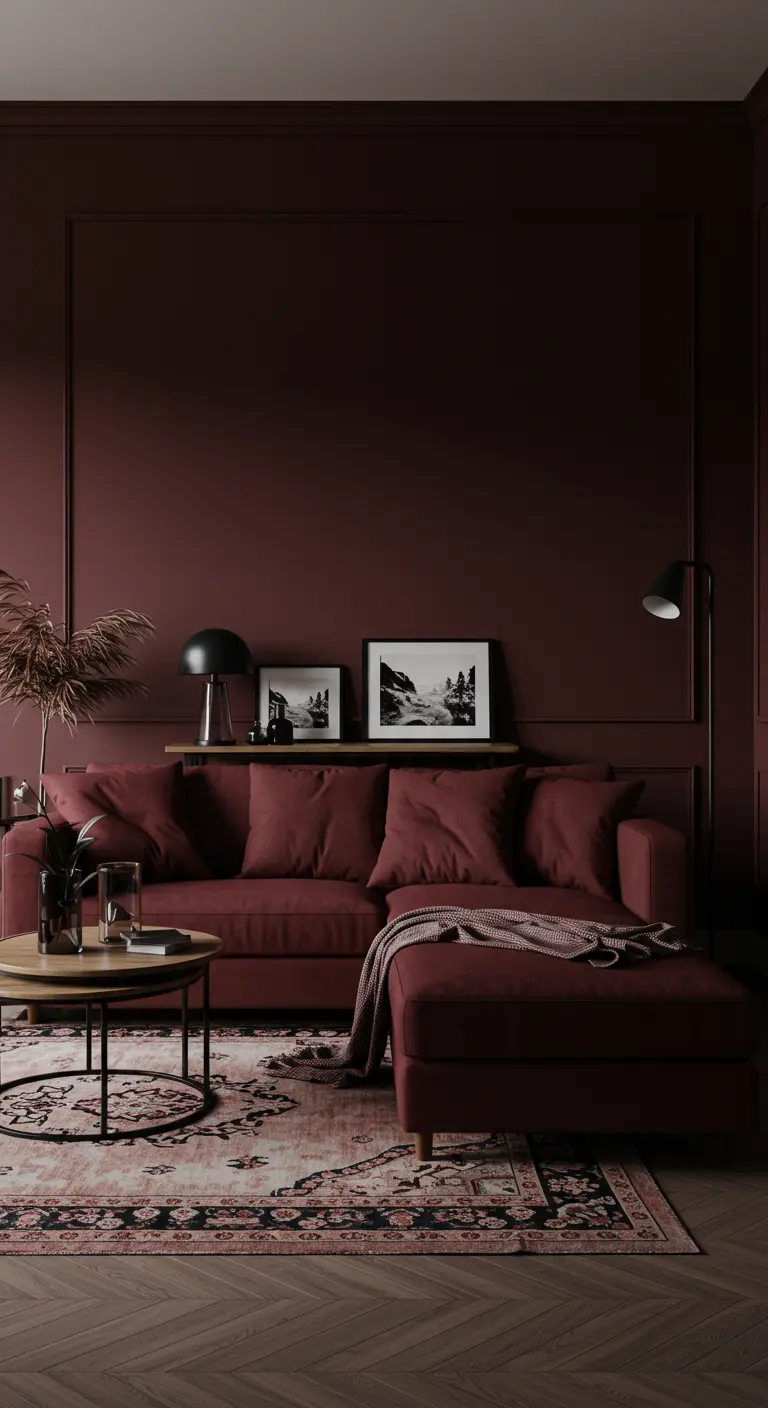
Elevate a simple room by adding subtle architectural details before you paint.
Thin picture frame molding, painted the same deep burgundy as the walls, adds a layer of classic sophistication and depth.
A rich color creates a dramatic and cozy backdrop for a plush, comfortable sectional.
Ground the room with a traditional patterned rug that picks up on the wall color, tying the whole scheme together.
This approach can make a room feel like one of those enchanted library themes, full of stories and warmth.
19. The U-Shaped Nook for Ultimate Coziness
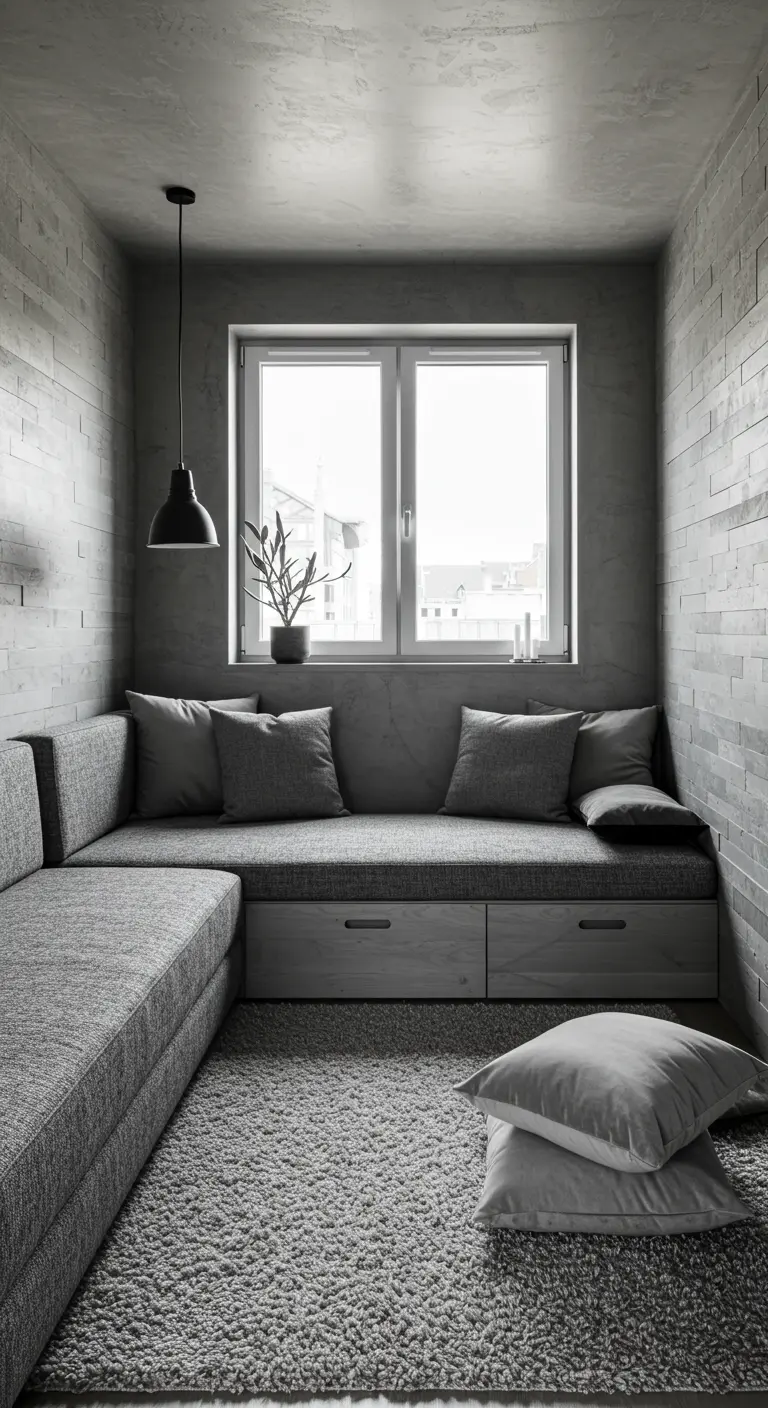
Maximize a small, contained area by building in a U-shaped sofa that fills the space wall-to-wall.
This creates an incredibly cozy and inviting “pit” seating area that encourages conversation and lounging.
Integrated drawers underneath provide essential storage for blankets and pillows.
Using textured wall treatments, like these stone tiles, adds depth and interest.
A deep-pile shag rug enhances the feeling of plush comfort, turning this into one of the best cozy corners for small rentals or homes.
20. The Power of Pure White

Create the ultimate serene, light-filled retreat by committing to an all-white palette.
The key to success is layering different textures and tones of white to add depth and warmth.
Combine a crisp white sofa with soft linen pillows, sheer voile curtains, and a painted white floor.
The effect is ethereal and expansive.
Simple, black-and-white line art provides a focal point without disrupting the minimalist romantic calm.
21. Defy Gravity with Wall-Mounted Storage

Free up floor space and create a lighter, more open feeling with wall-mounted storage cabinets.
By floating the cabinets above the sofa, you maintain an unbroken line of sight across the floor, which makes the room feel larger.
Choosing cabinets in the same color as your sectional creates a strong, intentional design statement.
This L-shaped configuration makes smart use of a corner, turning it into a highly functional and stylish feature.
It’s a great strategy for elevated studio apartment designs.
22. Monochromatic Serenity in Soft Green
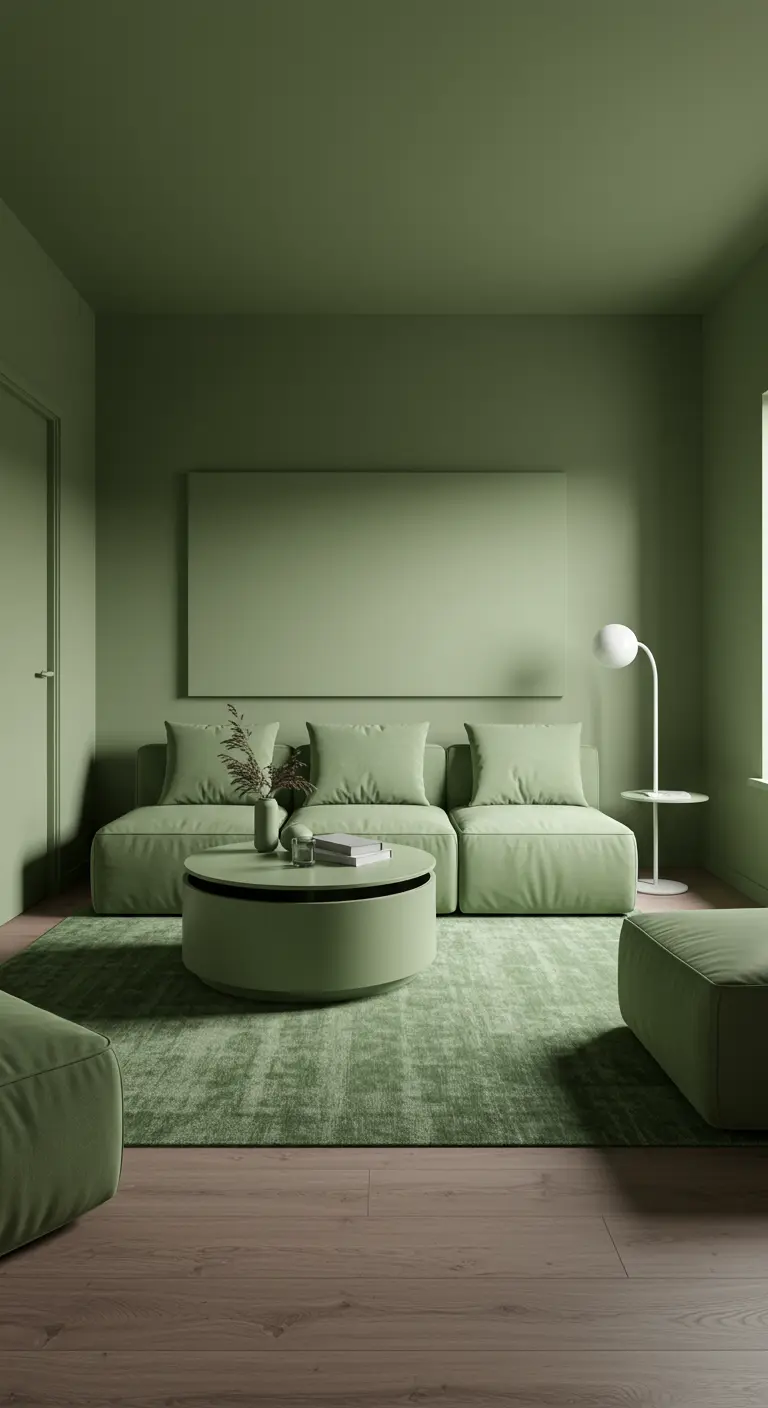
Achieve a tranquil, unified look with a soft, monochromatic color scheme.
Here, a muted sage green covers the walls, rug, sofa, and even the coffee table.
This creates a peaceful, meditative atmosphere.
To keep the look from becoming monotonous, introduce a large, textured canvas painted in the exact same shade as the wall.
This adds depth and an artistic touch without introducing a new color, echoing a Japandi interior sensibility.
23. Rich Velvet and Polished Brass
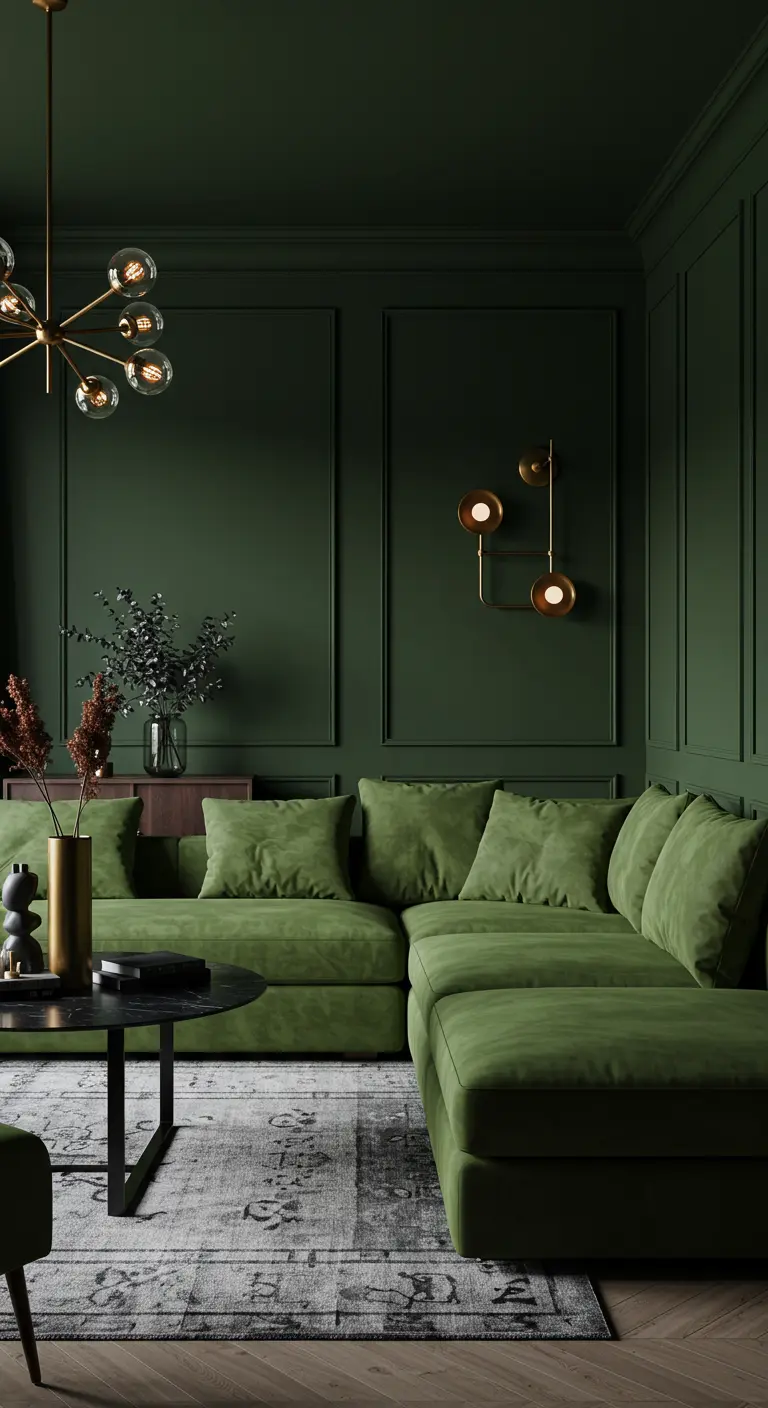
Combine deep, moody color with luxurious textures for a space that feels both dramatic and inviting.
Forest green walls with classic paneling provide an elegant architectural backdrop.
A large, L-shaped velvet sofa offers plush comfort and reflects light beautifully.
Introduce polished brass lighting fixtures to act as jewelry for the room, their warm metallic glow cutting through the dark tones.
This combination is central to creating emerald green rooms with a sophisticated, timeless feel.
24. Layer Textures in a Neutral Palette
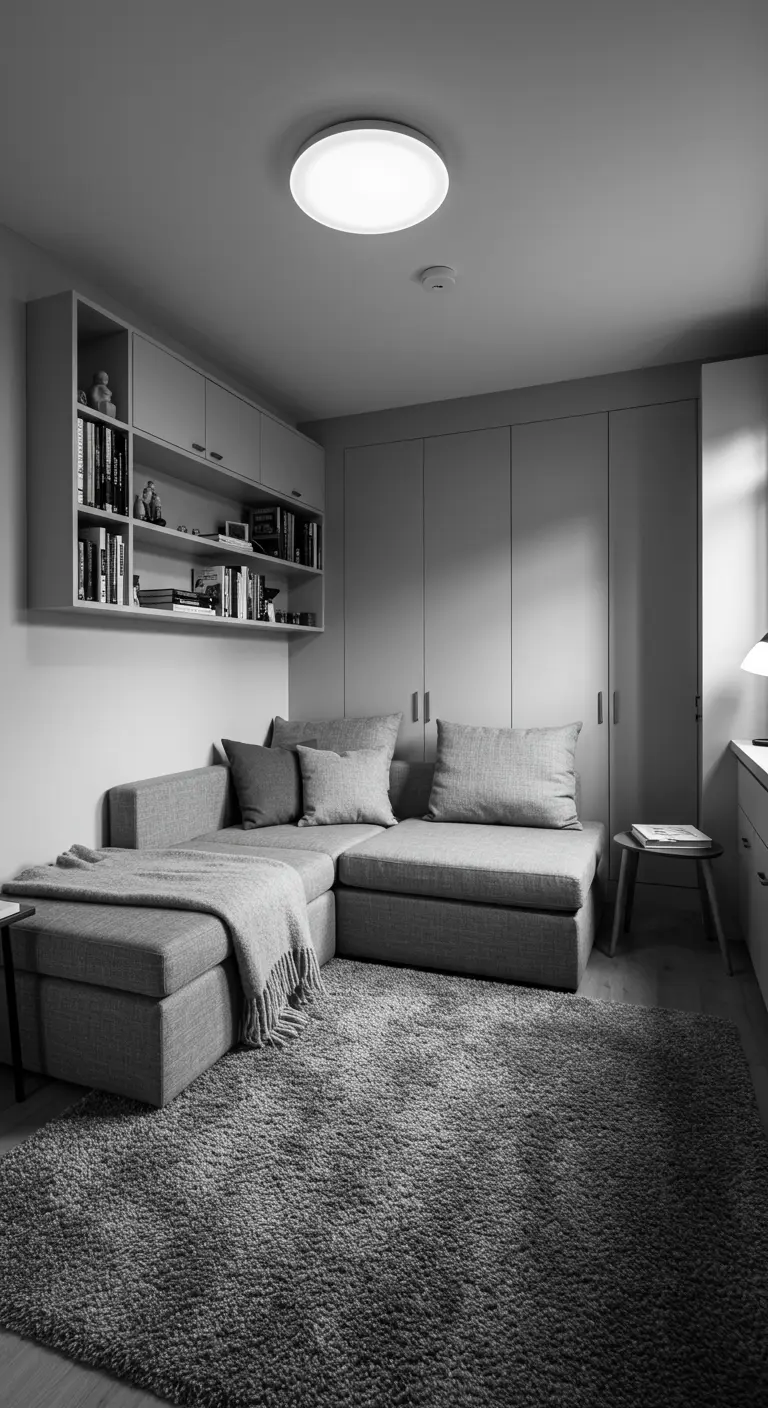
Even in a simple, neutral color scheme, you can create a rich and inviting space by layering textures.
A deep-pile shag rug feels luxurious underfoot and contrasts beautifully with the smooth, flat-weave fabric of the sectional.
A cozy knit throw adds another layer of softness.
Behind the sofa, seamless floor-to-ceiling cabinets provide ample storage while blending into the wall, keeping the focus on comfort.
This is a key principle in creating chic monochrome gray retreats.
25. The Ethereal Escape
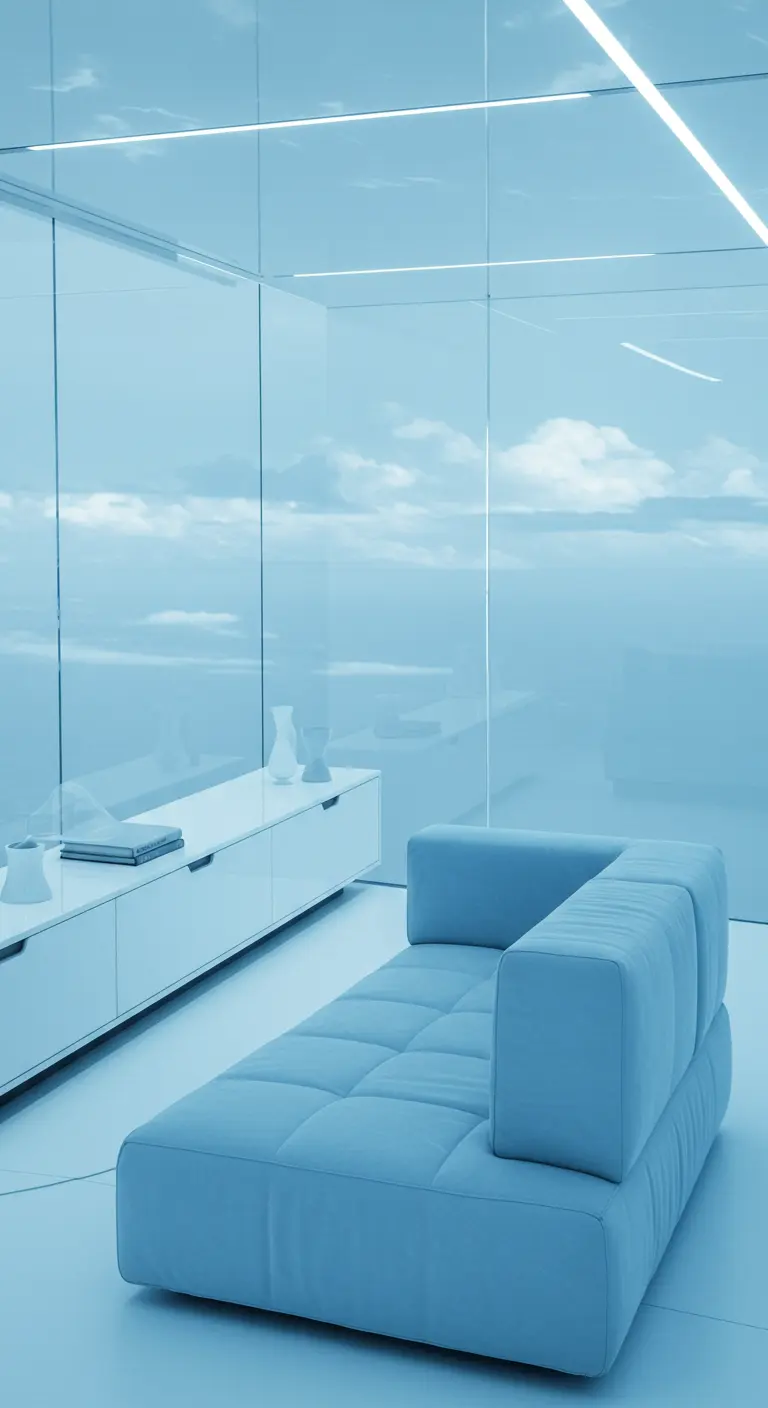
In an ultra-modern setting, think beyond traditional walls.
Glass partitions create a sense of boundless space while still defining the living area.
To soften the sleekness, choose a single piece of furniture with a gentle color and tactile form, like this tufted pale blue chaise.
Integrated LED strip lighting along the ceiling and floor enhances the futuristic, floating effect.
This is a design that prioritizes feeling over objects, creating a truly dreamy pastel haven.
26. Master Lighting in a Windowless Space
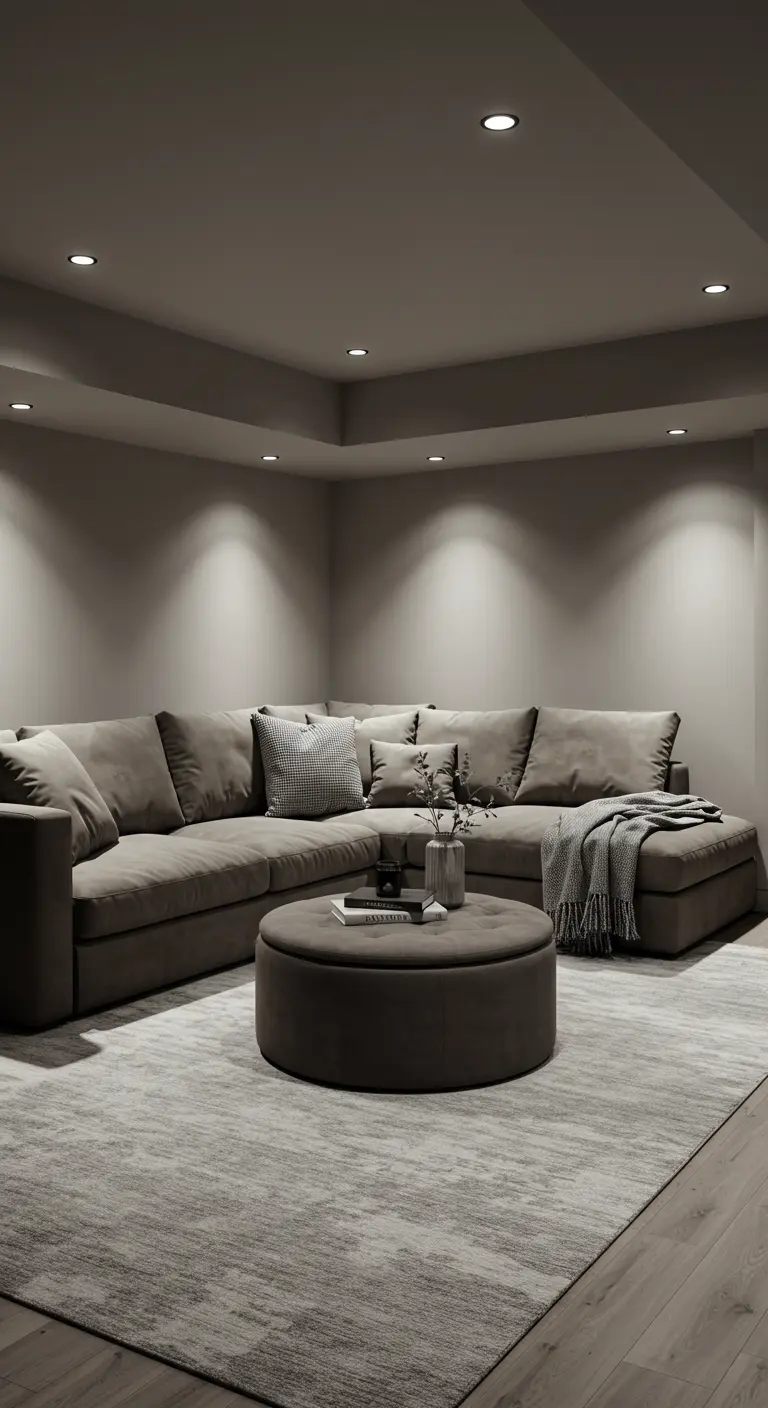
When you lack natural light, a strategic lighting plan is everything.
Use multiple recessed spotlights aimed at the walls to “wash” them with light; this makes the room feel brighter and taller than lighting the floor would.
Arrange a large, comfortable sectional to create a cozy, inward-facing conversation area.
A warm, neutral color palette helps reflect the artificial light, and a large, light-colored rug prevents the space from feeling dark underfoot.
It’s a smart way to design warm minimalist spaces, even without windows.
